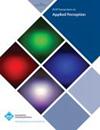Visual Enhancement of MR Angiography Images to Facilitate Planning of Arteriovenous Malformation Interventions
IF 1.9
4区 计算机科学
Q3 COMPUTER SCIENCE, SOFTWARE ENGINEERING
引用次数: 10
Abstract
The primary purpose of medical image visualization is to improve patient outcomes by facilitating the inspection, analysis, and interpretation of patient data. This is only possible if the users’ perceptual and cognitive limitations are taken into account during every step of design, implementation, and evaluation of interactive displays. Visualization of medical images, if executed effectively and efficiently, can empower physicians to explore patient data rapidly and accurately with minimal cognitive effort. This article describes a specific case study in biomedical visualization system design and evaluation, which is the visualization of MR angiography images for planning arteriovenous malformation (AVM) interventions. The success of an AVM intervention greatly depends on the surgeon gaining a full understanding of the anatomy of the malformation and its surrounding structures. Accordingly, the purpose of this study was to investigate the usability of visualization modalities involving contour enhancement and stereopsis in the identification and localization of vascular structures using objective user studies. Our preliminary results indicate that contour enhancement, particularly when combined with stereopsis, results in improved performance enhancement of the perception of connectivity and relative depth between different structures.磁共振血管造影图像的视觉增强以促进动静脉畸形干预计划
医学图像可视化的主要目的是通过促进对患者数据的检查、分析和解释来改善患者的治疗效果。只有在交互式显示的设计、实现和评估的每一步都考虑到用户的感知和认知限制,这才有可能。医学图像的可视化,如果有效和高效地执行,可以使医生以最小的认知努力快速、准确地探索患者数据。本文描述了生物医学可视化系统设计和评估的具体案例研究,即磁共振血管造影图像的可视化用于规划动静脉畸形(AVM)干预。AVM干预的成功很大程度上取决于外科医生对畸形及其周围结构的解剖结构的充分了解。因此,本研究的目的是通过客观的用户研究来研究包括轮廓增强和立体视觉在内的可视化模式在血管结构识别和定位中的可用性。我们的初步结果表明,轮廓增强,特别是当与立体视觉相结合时,可以提高不同结构之间的连接和相对深度感知的性能增强。
本文章由计算机程序翻译,如有差异,请以英文原文为准。
求助全文
约1分钟内获得全文
求助全文
来源期刊

ACM Transactions on Applied Perception
工程技术-计算机:软件工程
CiteScore
3.70
自引率
0.00%
发文量
22
审稿时长
12 months
期刊介绍:
ACM Transactions on Applied Perception (TAP) aims to strengthen the synergy between computer science and psychology/perception by publishing top quality papers that help to unify research in these fields.
The journal publishes inter-disciplinary research of significant and lasting value in any topic area that spans both Computer Science and Perceptual Psychology. All papers must incorporate both perceptual and computer science components.
 求助内容:
求助内容: 应助结果提醒方式:
应助结果提醒方式:


